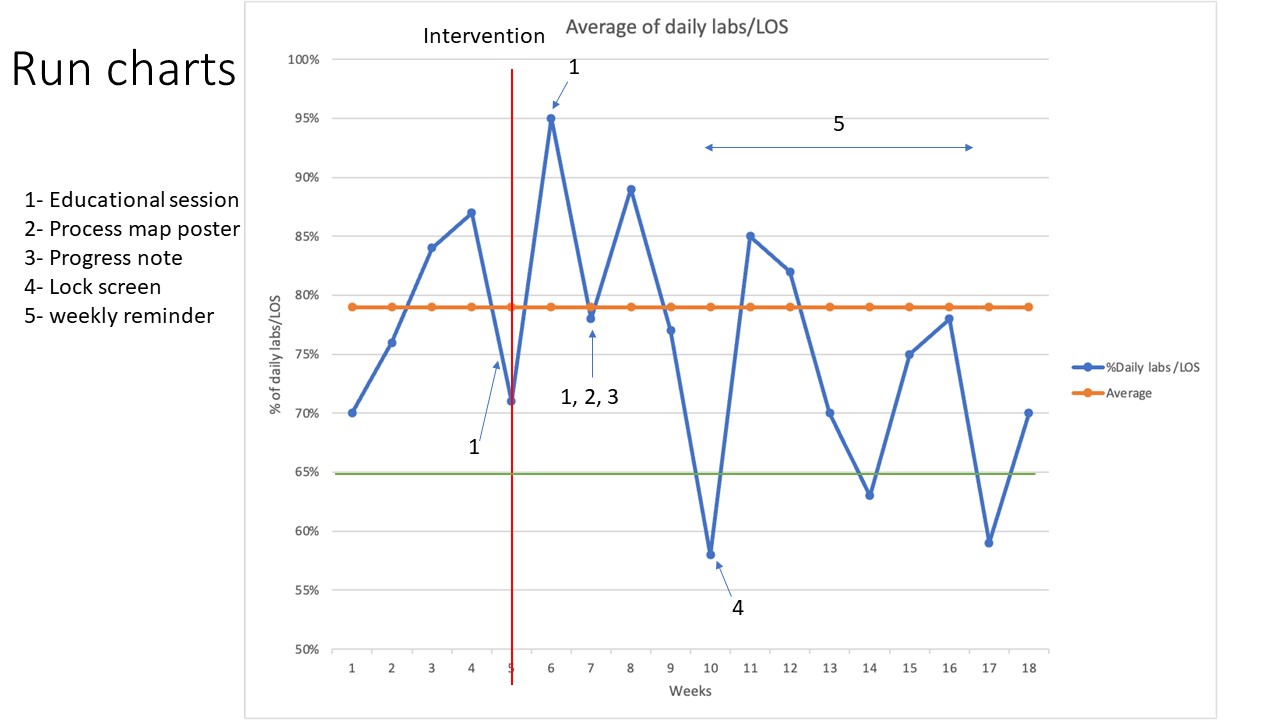Background: The Society of Hospital Medicine’s Choosing Wisely recommendations include avoiding repetitive Complete blood count (CBC) and serum electrolyte panels (SEPs). SEPs include basic and comprehensive metabolic panels (BMP, CMP respectively). Unnecessary routine lab can cause increased costs(1)(2), unnecessary downstream testing and procedures, hospital acquired anemia(2)(3)(4) and patient discomfort. Multiple QI project has been successful without increasing the rates of readmission or length of stay(5)(6)(7). As one of the efforts, Minnesota Lab Appropriateness Criteria(8) is developed to evaluate the effectiveness of routine lab.
Purpose: The reduction of the ordering of routine morning labs (represented by the ratio of the number of labs to the length of stay) of hospitalized patients on teaching teams in 4D &6D nursing units from 80% to 65% by May 2023.
Description: Pilot chart review for routine labs from June 2022 to July 2022 was performed on inpatient medicine floor. Patient lists were populated by EPIC system and groups were stratified as “teaching” vs “nonteaching”. Patients with hematologic malignancy and length of stay less than 3 days were excluded in the review. In addition, hospitalists and residents were surveyed on their practice habits. Based on the chart review and survey, the resident group was decided as a target of the quality improvement project. Multiple PDSA cycles were implemented including education sessions on routine lab draws on residents and attendings, hard stop in progress notes, email reminders to the residents and attendings, and posted signs in documentation room and computer screens. From February 2023 to June 2023, Repeat chart review was performed for each cycle. Reviewed variables included routine lab result, hemoglobin change, 30 day readmission, transfusion, labs on discharge day, and length of stay. In the pilot chart review, the percentage of routine lab for residents was 80%. The run chart showed a shift of the percentage of routine labs and 3 data points met the goal percentage under 65%. Due to technical issues, the readmission rate was not fully available. When calculated with available data, readmission rate decreased from 16% to 7%, comparing pilot data and end of the study.
Conclusions: The purpose of this project was to decrease the unnecessary routine lab draws. Our project implemented multiple educational sessions and reminders to successfully decrease the rate of routine labs. One significant limitation to our project is the incomplete data regarding readmission rates. We were also able to observe changes in the residents’ behavior. Though it was not officially reviewed, we noted a change. Previously CBC and CMP were ordered together as a default but during our project we noted that only the clinically relevant lab was ordered. Given the successful reduction in the labs, the education in lab stewardship for residents appears to be effective. Also, the hard stop in progress notes triggered to document a reason when ordering routine labs also helped. Due to the nature of the quality improvement project, we compared June-July to February to June. Increase in residents’ knowledge might have influenced the result. In the pilot study, given early start of academic year, most of the routine labs were ordered from senior residents.

